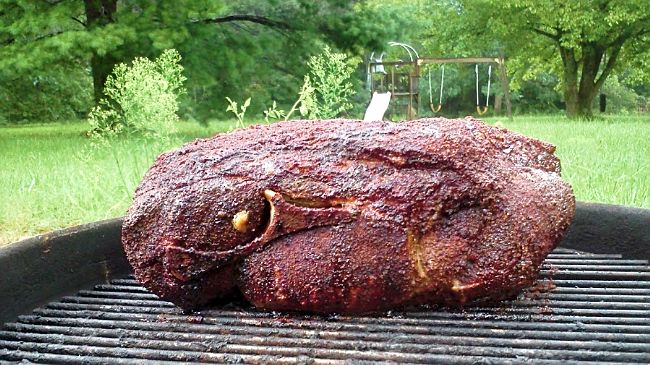
Hello! I’m wax, and today I’ll be talking to you about how to make pulled pork using nothing more than a Weber grill and a lot of patience (ok, maybe a few more things, but we’ll get to that). Usually you have a big honking smoker, or at least something more akin to a drum than a grill.
When a smoker is loaded with a heap of coal, it can be left to smolder for hours and will keep a consistent low temperature, while the coals in a grill will instead burn hot and quickly. However, through a bit of research, and some practice, I’ve found that there is a good way to heat my grill to 250°F and sustain it for hours. Using this “snake” method you can limit the amount of charcoal that is lit at any given time, and achieve consistent temperatures for ten hours without adding briquettes.
First, the Grill
Arrange the coals in a long chain along the outer edge of the charcoal grate. Start by lighting the beginning of the chain. The next coals in the chain will take a while to start burning, so you will always have a small amount of coal burning (the chain’s width) for a long time. A few pieces of wood placed at the beginning of the chain give the pork barbecue’s characteristic smoky flavor. Place about four sports worth of charcoal into a starter (in my case this is ~12 briquettes). When the coals are ready place them at the beginning of the chain (this is the side with the wood on top). Place a piece or two of smoking wood on the top of your hot coals.
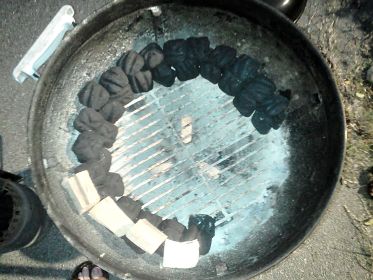
If you’re super concerned about getting your temperatures in the right range (and I highly recommend this if you haven’t tried this before) you can get a fryer thermometer and place it in one of the vents of your grill. This will give you a good idea of what your temp is without the need to lift the lid every time you want to check.
Once your grill is lit, put your grate on and close the lid. Leave the vents all the way open until you’re close to your desired temperature. I usually wait about 20-30 minutes. This is a great time to get your meat prepared.
Then, the meat
The most basic thing to do with pulled pork is to put a seasoning rub on it prior to cooking. This is what I do. I use a basic barbecue rub, the only modification that I make is to use slightly less cayenne pepper as it can get a bit too spicy for my family. It’s very basic, but compliments the smoked flavor of the pork very well. After my rub is prepared (in this case I had some left over from a previous cook) sprinkle it generously over the entire surface of the Boston butt. The amount of rub determines both the amount of bark you get when you are finished and also the spiciness of the final product so keep that in mind as you apply your seasoning.
When I have the pork prepared I head back outside and start closing the bottom vents of the grill. One of the really important things here is to only control your airflow with the bottom vents. The top vents need to stay all the way open when we are smoking so that the smoke is free to escape. Not doing so can cause a bitter taste in the meat.
Time for patience
Once the smoker has settled into temperature (about ¾ to an hour after closing the lid), it’s time to put your meat on. Place your meat on the opposite side from the lit portion of coals. After doing this, make sure to place the lid vents on the same side as the meat. This will help limit the amount of both heat lost and air flow to the coals.
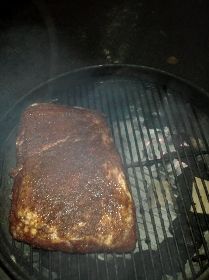 Once the meat is on the grill, the most important thing you can do for the meat is to leave it alone. Every time you open the grill you let heat escape and increase the required cook time. This isn’t a huge deal with a small-volume grill, but it will have an impact. (If you have to look, you might try introducing a foil pie plate with some water in it to provide some additional thermal mass, and as a bonus also doubles as a catch tray for juices and rendered fat from the meat which make an excellent addition to a barbeque sauce).
Once the meat is on the grill, the most important thing you can do for the meat is to leave it alone. Every time you open the grill you let heat escape and increase the required cook time. This isn’t a huge deal with a small-volume grill, but it will have an impact. (If you have to look, you might try introducing a foil pie plate with some water in it to provide some additional thermal mass, and as a bonus also doubles as a catch tray for juices and rendered fat from the meat which make an excellent addition to a barbeque sauce).
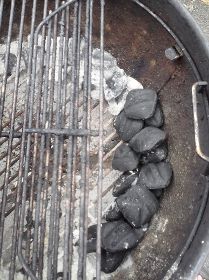 Give yourself about 1.5-2 hrs/lb. The desired internal temperature is 190–200°F depending on how much chew you’d like the meat to have. I usually cook overnight, checking about every 4 hours to make sure that the meat is as far away from the currently lit coals as possible, and also that there are enough unlit coals for the cook to continue for another 4 or so hours.
Give yourself about 1.5-2 hrs/lb. The desired internal temperature is 190–200°F depending on how much chew you’d like the meat to have. I usually cook overnight, checking about every 4 hours to make sure that the meat is as far away from the currently lit coals as possible, and also that there are enough unlit coals for the cook to continue for another 4 or so hours.
To add more coals I purchased a grate that has flaps that lift up so that I can tend the fire underneath, however if you do not have this, remove the entire grate (with the meat still on it) and place it on some blocks (be super careful with this, the grate is very hot). Alternatively you can try to place coals through the edge of the grate using tongs (this is quite challenging).
Ready!
There are several ways to check if your meat is done. In the past I’ve used both traditional or wireless thermometers. However, these days I look at the bone. When the meat has pulled away from the bone and the bone moves freely when moved back and forth then the meat is done and ready to come off the grill.When the meat is done, I pull it off the grill right onto a cookie sheet (this is easier than trying to pick up the meat with tongs or spatulas or basically anything else). To do this I lift on end of the meat up and slide the cookie sheet underneath it, then push the cookie sheet under the rest of the way. Carefully lift the cookie sheet off the grill. Cover it with a bit of foil to rest.
After a little while your meat is ready to pull. Dig in and pull the meat apart. Depending on how long you let it rest (and cool) it will likely be very hot so be careful. Once your meat is pulled you’re ready to serve (feel free to mix a bit more rub into the finished product if you don’t think the flavor is bold enough).
My favorite way to serve this is on buns with coleslaw, chips on the side, sauce is optional.

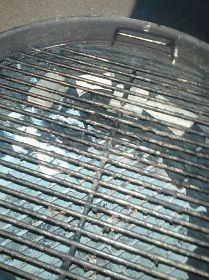

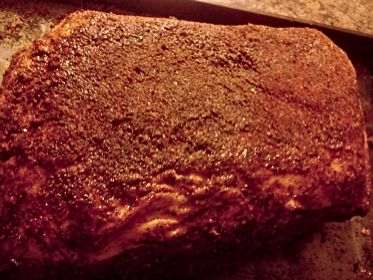
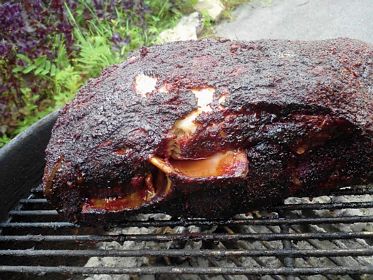
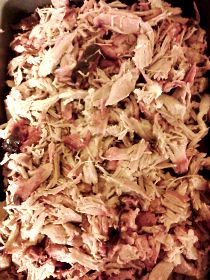
Doing the ring of coals is a really clever idea. I wish I’d seen this 5 years ago when I was still smoking on a Webber.
I tried the snake method for the first time with a 3.5 lb boneless pork roast (rubbed). I used 44 unlit briquettes and six lit coals along with three bundles of applewood chips in my 20 year old Webber kettle. I got a three hour burn at 225 – 250 degrees throughout. The roast was cooked to perfection with a nice crust. I let it rest in foil for about half an hour.
My wife is STILL raving about it.
I actually try to keep my temperature around 225. I use a charcoal holder instead of the ring but I have to open the lid every hour. I think I am going to try the ring of coals instead. Thanks